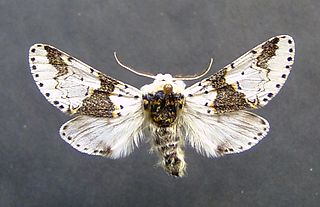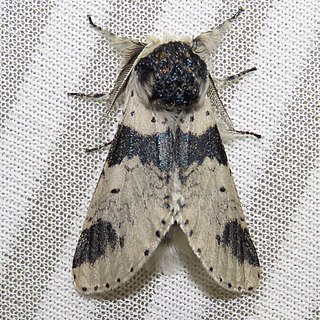Moritz Balthasar Borkhausen was a German naturalist and forester. He took part in the production of Teutsche Ornithologie oder Naturgeschichte aller Vögel Teutschlands in naturgetreuen Abbildungen und Beschreibungen by Johann Conrad Susemihl.

Notodontidae is a family of moths with approximately 3,800 known species. The family was described by James Francis Stephens in 1829. Moths of this family are found in all parts of the world, but they are most concentrated in tropical areas, especially in the New World.

The poplar kitten is a species of moth in the family Notodontidae. The species was first described by Nikolaus Joseph Brahm in 1787. They are found throughout Europe and in North Africa, Mongolia, Kazakhstan and Xinjiang.

The genus Calyptra is a group of moths in subfamily Calpinae of the family Erebidae. They are a member of the Calpini tribe, whose precise circumscription is uncertain but which includes a number of other fruit-piercing or eye-frequenting genera currently classified in Calpinae.

Noctua is a genus of moths. They have dull, cryptic forewings and often very bright hindwings. These are hidden under the forewings when the moths rest, leading to their common name of yellow underwings. They are not particularly closely related to the "true" underwing moths (Catocala) though, apart from both being Noctuoidea. They are good fliers.

Furcula furcula, the sallow kitten, is a moth from the family Notodontidae. It was first described by the Swedish entomologist Carl Alexander Clerck in 1759 from a specimen found in Sweden.

Xanthorhoe biriviata, the balsam carpet, is a moth of the genus Xanthorhoe in the family Geometridae. The species was first described by Moritz Balthasar Borkhausen in 1794. It is found "widespread in Europe and temperate Asia. In southern Europe the distribution is restricted only locally to the mountain(s)."

Drepana curvatula, the dusky hook-tip, is a moth of the family Drepanidae. It was first described by Moritz Balthasar Borkhausen in 1790 and it is found from Europe to Japan.

Furcula is a genus of moths of the family Notodontidae. The genus was described by Jean-Baptiste Lamarck in 1816.

Furcula occidentalis, the western furcula moth, double-lined furcula or willow kitten , is a moth of the family Notodontidae. It is found from southern Yukon and British Columbia to Nova Scotia, south to Maryland and west to Utah and Oregon.

Drepana is a genus of moths belonging to the subfamily Drepaninae. The genus was erected by Franz von Paula Schrank in 1802.

Dyspessa is a genus of moths belonging to the family Cossidae. It was described by Jacob Hübner in 1820.

Drepana uncinula, the spiny hook-tip, is a moth in the family Drepanidae.

Furcula scolopendrina, the zigzag furcula moth or poplar kitten moth, is a species of prominent moth in the family Notodontidae. It was described by Jean Baptiste Boisduval in 1869 and is found in North America.

Furcula modesta, the modest furcula or modest kitten, is a species of moth in the family Notodontidae. It was first described by Hudson in 1891 and it is found in North America.
This page is based on this
Wikipedia article Text is available under the
CC BY-SA 4.0 license; additional terms may apply.
Images, videos and audio are available under their respective licenses.













